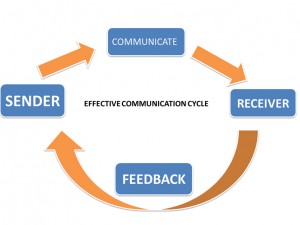 Communication is commonly talked about in terms of a cycle. In any communication, the principal characters are known as the sender and the receiver:
Communication is commonly talked about in terms of a cycle. In any communication, the principal characters are known as the sender and the receiver:
- Ideas exist in the sender’s brain as electrochemical neuron systems, not words.
- Encoding is what happens when we convert these electrochemical impulses to sounds (or writing) – words and sentences so they can be transmitted.
- Decoding is what happens at the other end – the receiver’s brain converts the bits of sound back to electrical impulses
If communication succeeds, the sender’s exact (or close) ideas end up in the receiver’s brain as electrical energy ready for decoding. Responsibility for successful communication lies with the person transmitting the message.
